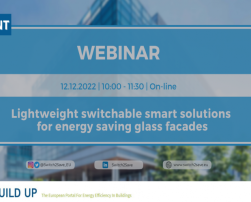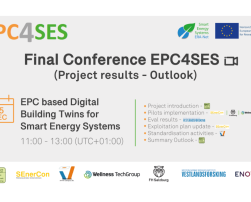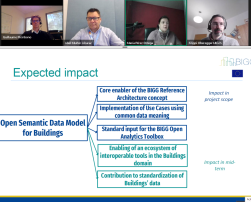
The 12th December from 10.00H to 11.30H CET, the Switch2Save project organised a webinar entitled "Lightweight switchable smart solutions for energy saving glass facades". The session was hosted by BUILD UP.
WATCH IT HERE.

The 12th December from 10.00H to 11.30H CET, the Switch2Save project organised a webinar entitled "Lightweight switchable smart solutions for energy saving glass facades". The session was hosted by BUILD UP.
WATCH IT HERE.
2022 has been one of the most hectic years for the energy sector: energy crisis, consumption reduction, and zero carbon objectives. This has only strengthened the challenges Energy professionals have been facing for many years now. More than ever, the objective of sustainable energy management is at the heart of the public debate, notably due to the reinforcement of regulations and the awareness of the energy and ecological transition. This call is crucial if we want to achieve carbon neutrality as soon as possible.

EPC4SES will celebrate its final conference with the title "EPC based Digital Building Twins for Smart Energy Systems" on December 15th to provide a final overview of the project activities and general outcomes.

The BIGG project organized on November 8 the standardization workshop “Leveraging on standardisation for building data aggregation and analytics” in collaboration with the sister projects MATRYCS and BuiltHub and hosted by BUILDUP.

The CINDERELA Project has developed the CinderOSS tool which is a One-Stop-Shop service representing a digital business environment and supporting new business models for a sustainable urban construction. The tool is currently an open beta version.

The International Energy Agency has just published "Energy Efficiency 2022" which provides an analysis of the global trends and developments about energy efficiency investments, technology, innovation, demand and policies.
Creating NEBourhoods Together proposes Munich-Neuperlach as test-bed for urban innovation landscapes.

This study aims to assist the Commission with identifying policy options that support the uptake of “Circular economy principles for buildings’ design” in European, national and local policies. The goal is to increase the service life of buildings, and facilitate the use of secondary materials.

Consortium partners VITO-Energyville and Demokritos are modelling the behaviour of the various RES4BUILD system components – heat pumps, solar panel yields, long- and short-term heat storage, and the building thermal mass. One of the ways to model a building’s thermal mass is to estimate the indoor temperature given the ambient conditions and the inputs i.e. outdoor temperature, solar irradiance incident, heating/cooling. The project’s approach uses grey box models to approximate the building model by grouping various physical components together, and then identifying the parameters corresponding to the grouped components in a data driven way. They capture the thermodynamics to a certain extent but are also easily applied across buildings because of this data driven approach. Once ready, the models of the various components can be used in a framework for optimal control of the system to maximize self-consumption or minimize use of fossil fuels and costs.

It is urgent to study the best sustainable designs for warm climate zones to unleash their market and research potential, thus popularising these concepts to a broader audience. These designs involve bioclimatic approach, low-energy cooling techniques and the use of local construction materials, some of which already exist in Africa and only need to be identified and adapted. Combining these next-generation approaches with the best bioclimatic solutions will be the hallmark of the ABC 21 project.